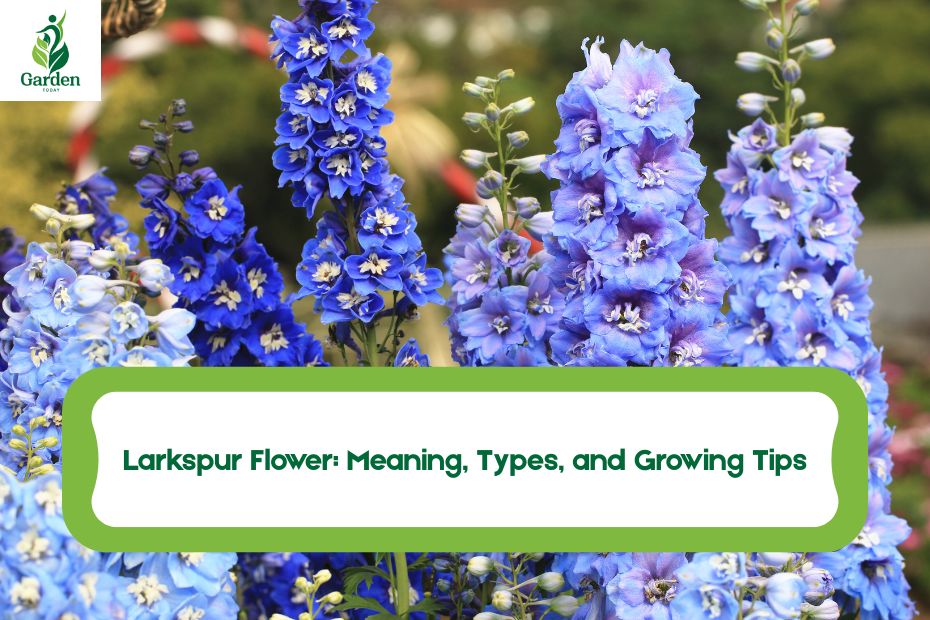Larkspur flowers are beautiful, tall, and colorful blooms that add charm to any garden or bouquet. Known for their spiky petals and vibrant shades, these flowers are popular in gardens, weddings, and floral arrangements. Whether you’re a beginner or an experienced gardener, this guide will help you understand the meaning of larkspur, its different types, and easy growing tips.
What is a Larkspur Flower?
Larkspur (scientific name: Delphinium) is a flowering plant that belongs to the buttercup family. These flowers grow in tall spikes with clusters of small blooms in shades of blue, purple, pink, and white. They are often confused with delphiniums, but larkspurs are usually annuals, while delphiniums are perennials.
Larkspurs are loved for their:
- Tall, elegant stems
- Bright and varied colors
- Ability to attract bees and butterflies
- Use in bouquets and wedding decor
Meaning and Symbolism of Larkspur Flowers
Larkspur flowers have different meanings based on their colors:
- Blue Larkspur – Symbolizes dignity and grace.
- Purple Larkspur – Represents first love and sweet memories.
- Pink Larkspur – Stands for romance and youthfulness.
- White Larkspur – Means happiness and purity.
In the Victorian era, people used flowers to send secret messages, and larkspur was often associated with lightness and joy. It’s also the birth flower for July, making it a special gift for summer birthdays.
Different Types of Larkspur Flowers
There are many types of larkspur, each with unique features:
- Annual Larkspur (Consolida ajacis) – Grows quickly and blooms in one season. Perfect for beginners.
- Perennial Larkspur (Delphinium) – Comes back every year but needs more care.
- Dwarf Larkspur – Shorter plants, great for small gardens.
- Giant Larkspur – Can grow up to 6 feet tall, ideal for back borders.
- Wild Larkspur – Found in meadows and natural landscapes.
Popular varieties include:
- ‘Imperial Larkspur’ – Bright blue flowers.
- ‘Sublime Larkspur’ – Soft pastel shades.
- ‘Pacific Giant’ – Large, showy blooms.
How to Grow Larkspur Flowers
1. Planting Larkspur Seeds
- Best Time to Plant: Early spring or fall (in mild climates).
- Soil: Well-draining, slightly alkaline soil.
- Sunlight: Full sun (at least 6 hours a day).
- Spacing: Plant seeds 12 inches apart for good airflow.
2. Watering and Care
- Water regularly but avoid soggy soil.
- Add mulch to keep roots cool.
- Use a balanced fertilizer once a month.
3. Pruning and Deadheading
- Remove dead flowers to encourage new blooms.
- Cut back stems after flowering to promote growth.
4. Common Pests and Diseases
- Watch out for aphids and slugs.
- Prevent mildew by spacing plants properly.
Uses of Larkspur Flowers
Larkspurs are not just pretty—they have many uses:
- Wedding Bouquets – Their tall stems add elegance.
- Garden Borders – Perfect for cottage-style gardens.
- Dried Flowers – Last long in dried arrangements.
- Pollinator Gardens – Attract bees and butterflies.
Warning: Larkspur is toxic to pets and humans if eaten. Handle with care!
Final Thoughts on Larkspur Flowers
Larkspur flowers are stunning, easy to grow, and full of meaning. Whether you want to brighten your garden or create a beautiful bouquet, these flowers are a great choice. With proper care, they’ll bloom all season, adding color and life to your space. Try planting some larkspur seeds and enjoy their beauty!
Visit Garden Today
1. Are larkspur flowers poisonous?
Yes, larkspur flowers are toxic to humans and pets (especially cats, dogs, and horses) if ingested. Always handle them with care and keep them away from children and animals.
2. Can larkspur grow in pots?
Yes! Dwarf larkspur varieties grow well in pots. Use well-draining soil, place them in full sun, and water regularly for best results.
3. How long do larkspur flowers bloom?
Larkspur flowers typically bloom for 4-6 weeks in early to mid-summer. Deadheading (removing faded blooms) can help extend flowering.
4. Do larkspur flowers attract bees and butterflies?
Yes! Larkspurs are bee-friendly and attract pollinators like butterflies, making them great for eco-friendly gardens.
5. What’s the difference between larkspur and delphinium?
Larkspur (Consolida) is usually an annual with smaller flowers, while delphinium is a perennial with larger blooms. Both look similar but have different growth habits.
